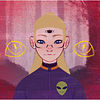Take a photo of a barcode or cover
dark
literally i will be thrilled and intrigued by even passing mentions of arctic exploration. can'tbelieve they had their own franklin expedition. i hope we get to learn more about the baste ana & baru's arctic.... PLEASE!!!
all in all phenomenal once again. one must respect baru's hustle. there weren't any significantly slower parts of this book which was truly shocking since it's 600 pages long so even outside of the impressive worldbuilding & plotweaving, there's something to be said for dickinson's capability for keeping things engaging! especially with multiple povs. i will await the last baru book with patience and in the meantime remember to stay grateful that these books were written at all.
all in all phenomenal once again. one must respect baru's hustle. there weren't any significantly slower parts of this book which was truly shocking since it's 600 pages long so even outside of the impressive worldbuilding & plotweaving, there's something to be said for dickinson's capability for keeping things engaging! especially with multiple povs. i will await the last baru book with patience and in the meantime remember to stay grateful that these books were written at all.
adventurous
challenging
dark
tense
medium-paced
Plot or Character Driven:
A mix
Strong character development:
Yes
Loveable characters:
Yes
Diverse cast of characters:
Yes
Flaws of characters a main focus:
Yes
If you've looked at other reviews for the series, you may have seen book 2, The Monster Baru Cormorant, referred to as the series' "sophomore slump." I disagree, but I understand where the feeling comes from. The Monster feels like a prelude, a setting of the board, for The Tyrant. The Monster puts all the pieces in place for the cascade of schemes and plays that come in The Tyrant. They almost feel like one book split into two (which is fair—taken together, they represent about a thousand pages and would make for one mammoth novel).
If you felt like Baru was too passive in The Monster and that there wasn't enough scheming going on, I can happily report those things are wholly rectified in The Tyrant. Having located the infamous and quasi-mythological Cancrioth at the end of The Monster, Baru wastes no time in whipping into full savant plotting mode.
The book starts off strong, with a clever framing: Baru is recollecting her encounter with the Cancrioth and what came after to a troublingly gentle Farrier, who is probing her for certain specifics. (And by the way, Dickinson takes the cake for the most creative use of cancer I've ever seen in a fantasy novel.) This, combined with the occasional flashback continuing the story of Prince Hill, make for a beautifully chronologically 3D look at our story, as past, present, and future all orbit around each other until they finally connect fully.
Here we really see Baru and Yawa's rivalry take off, and it's delightful to watch these two go at it: the young upstart savant and the time-tested, battle-scarred old schemer. Even when they're aiming for the same goal they can't help but be at odds! And Dickinson never lets either of them slouch to give the other an easy win: he continues to excel at making sure the players around Baru are working actively towards their own goals, presenting reasonable challenges even to Baru's quick mind.
Tau-indi continues to be a standout character for me, and I'm not convinced their take on the world won't win out in the end. As they continue to press the importance of personal connection, and Baru questions who she's helping (or hurting) with her plans, and what the real victory will be, everyone around can't seem to stop themselves from wondering if Tau has a valid point about trim. This is perhaps nowhere truer than in the final reveals that bring the full story of Farrier, Cosgrad, and the Prince Hill trio into the present timeline. These interpersonal relationships formed when all these people were much younger are still echoing around Falcrest, the Mbo, and the Ashen Sea as a whole.
The Tyrant perhaps more directly than the other two novels asks Baru what she is willing to sacrifice to destroy Falcrest. Already she has given up Tain Hu, her first love, to wield power as an unbound cryptarch. But in The Tyrant, Baru is confronted head-on with the civilian cost of taking Falcest out at the knees. Not of members of Falcrest's ruling class, but the everyday people both of Falcrest and of the other parts of the empire—of Aurdwynn, of Taranoki, of the Occupation. The Tyrant makes Baru confront whether she considers those lives a necessary loss to ensure Falcrest's downfall. In this way, the story never loses sight of the stakes, which Baru is constantly weighing—on one hand, the suffering and death caused by Falcrest itself, and on the other, the suffering and death which may result from knocking Falcrest out of play entirely. Dickinson balances them well.
Baru underwent a lot of change in The Traitor, but remained largely static throughout The Monster. Her character is much more dynamic in The Tyrant, and she undergoes a lot of character growth both within and in how she relates to others, and even in how she processes the memory of Hu. She's forced to confront parts of her past that drive her reckoning towards the above question about sacrifice, and I got the feeling by the end that Baru had finally truly positioned herself, clear and steeled, for the fight with the empire.
Also, we finally get a masquerade party—and really, how could we have a series called "The Masquerade" without having at least one masque? It goes just as well as you might imagine.
Based on the author's note, I'm not expecting to see book four anytime soon, but I will eagerly await it nonetheless—I absolutely must see this conclusion.
This was so much better than I expected- I was so terrified of more horrific things happening to Baru that I was afraid to get get my hopes up, but I felt quite satisfied at the end of Baru the Tyrant. Baru 3 retains all the lovely social commentary/mannerpunk elements of the previous two books and adds a generous dose of New Weird.
Baru the Tyrant felt like the lovechild that resulted from an orgy hosted by China Mieville, Ellen Kushner, and Ursula LeGuin. Kameron Hurley may have popped her head in the door at one point, too. Much of the plot of Baru 3 revolves around the Cancrioth, and after the absolutely gonzo reveal at the end of Monster, Seth D does not let us down. He’s pulled out all the weird dark frondy squiggly scrabbly screeching grotesquerie from the back of his clever brain and nimbly set it spinning aloft into an already complex juggling maneuver involving the political and economical machinations of the Oriati Mbo, Falcrest, Aurdwynn, Kyprananoke, and the Stakhieczi.
Without spoiling the plot, I will say that Tyrant is a bit more compassionate toward the reader in the long run but still has its share of nail-bitingly intense tension. It was considerably gorier and gooier than previous installments, so I’d avoid reading any scenes set on the Eternal while you’re eating. Still, it wouldn’t be a Baru novel if you didn’t spend pretty much all of it terrified that Dickinson is about to kill or maim someone you really care about, so grab your blankie while you read this one.
Another element that Baru 3 really nails is the exploration of the effect of gaslighting, trauma, and grief on both identity and memory, doing so in a way that really invites the reader to consider what it is to be human. This places Tyrant in a category I’ve come to think of as “tenderpunk,” along with Ann Leckie’s Imperial Radch, Elizabeth Bear’s White Space, N.K. Jemisin’s Broken Earth, and of course, Iain M Banks’ Culture, just to name a few.
Dickinson assures us that Baru 4 will come one day, but leaves us with enough plot resolution to bear waiting a while. He clearly put a lot of heart into this one, so he’s earned a rest. Baru the Tyrant has great energy and is a wild ride for all of its several hundred pages and has a damn satisfying conclusion while still leaving us with plenty of speculation about what will happen in the final book. I really enjoyed this one. Great work, Seth Dickinson!
Baru the Tyrant felt like the lovechild that resulted from an orgy hosted by China Mieville, Ellen Kushner, and Ursula LeGuin. Kameron Hurley may have popped her head in the door at one point, too. Much of the plot of Baru 3 revolves around the Cancrioth, and after the absolutely gonzo reveal at the end of Monster, Seth D does not let us down. He’s pulled out all the weird dark frondy squiggly scrabbly screeching grotesquerie from the back of his clever brain and nimbly set it spinning aloft into an already complex juggling maneuver involving the political and economical machinations of the Oriati Mbo, Falcrest, Aurdwynn, Kyprananoke, and the Stakhieczi.
Without spoiling the plot, I will say that Tyrant is a bit more compassionate toward the reader in the long run but still has its share of nail-bitingly intense tension. It was considerably gorier and gooier than previous installments, so I’d avoid reading any scenes set on the Eternal while you’re eating. Still, it wouldn’t be a Baru novel if you didn’t spend pretty much all of it terrified that Dickinson is about to kill or maim someone you really care about, so grab your blankie while you read this one.
Another element that Baru 3 really nails is the exploration of the effect of gaslighting, trauma, and grief on both identity and memory, doing so in a way that really invites the reader to consider what it is to be human. This places Tyrant in a category I’ve come to think of as “tenderpunk,” along with Ann Leckie’s Imperial Radch, Elizabeth Bear’s White Space, N.K. Jemisin’s Broken Earth, and of course, Iain M Banks’ Culture, just to name a few.
Dickinson assures us that Baru 4 will come one day, but leaves us with enough plot resolution to bear waiting a while. He clearly put a lot of heart into this one, so he’s earned a rest. Baru the Tyrant has great energy and is a wild ride for all of its several hundred pages and has a damn satisfying conclusion while still leaving us with plenty of speculation about what will happen in the final book. I really enjoyed this one. Great work, Seth Dickinson!
challenging
dark
mysterious
tense
medium-paced
Plot or Character Driven:
A mix
Strong character development:
Yes
Loveable characters:
Complicated
Diverse cast of characters:
Yes
Flaws of characters a main focus:
Yes
adventurous
dark
emotional
tense
medium-paced
Plot or Character Driven:
A mix
Strong character development:
Complicated
Loveable characters:
Complicated
Diverse cast of characters:
Yes
Flaws of characters a main focus:
Complicated
adventurous
challenging
dark
tense
medium-paced
Plot or Character Driven:
Plot
Strong character development:
Yes
Loveable characters:
Yes
Diverse cast of characters:
Yes
Flaws of characters a main focus:
Yes
i actually have no notes this time. i’m very happy with this third book. justified a lot of my complaints about how tain hu’s death was being treated and fleshed out barus character. amanita and tau are both doing well. i hope irajis ok? i’m assuming amanita is not actually kindalana’s child because itd be too obvious and also she had sex with cosgrad as well which would be too far. me and seth dickinson are finally on the same page
adventurous
dark
emotional
tense






